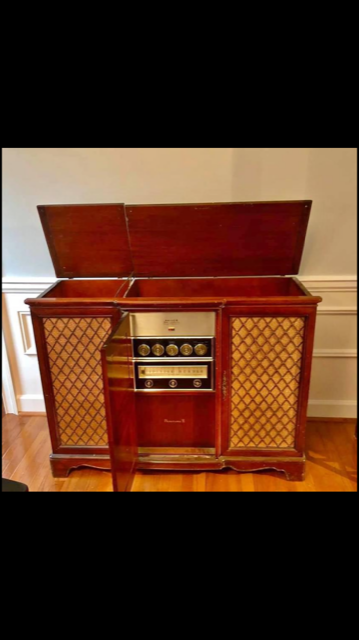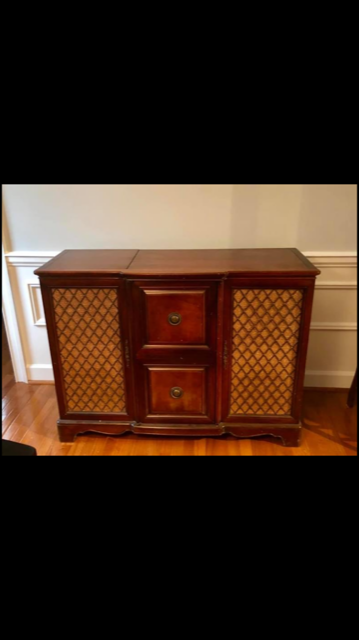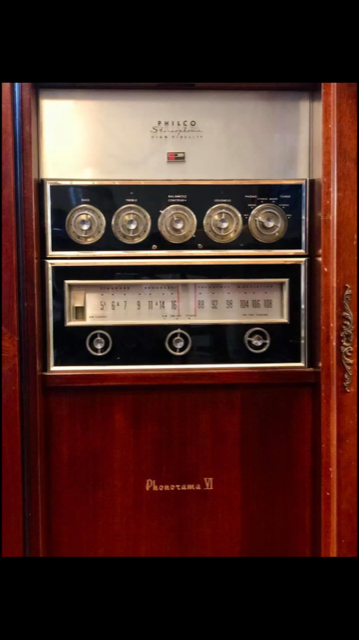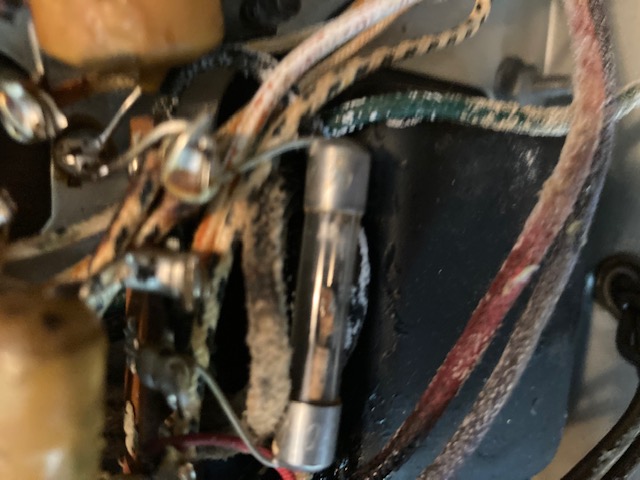H-1916 where to source caps and what type (recommendations?)
Posts: 2
Threads: 1
Joined: Jun 2020
City: Marietta
State, Province, Country: Georgia
Hello!
I recently received an H1916. Beautiful cabinet with a few nicks. Includes the 2 electrostatic speakers and an RT400 stereo receiver. No rusting anywhere except some very slight surface on one of the electrostatic grids in one area (but it shouldn't impede function.) The previous owners said it never turned on for them and they had it about a decade. Upon inspection I found that the soldered fuse was toast. I am hoping the fuse did its job well enough and protected the components after it. It also came with schematics, manual, and other info. The turntable is missing, but I'll worry about that later.




So far all the heater pins have checked out ok, but I haven't managed to get to all of them (there's quite a bit here.)
My intention is to not only replace the fuse, but also the paper caps and can. I have all the numbers off of caps but had a few questions and your assistance would be greatly appreciated!
Questions:
The fuse imprinting appears to be 250 70LT but I can't find anything with this number. The fuse was in rough shape so the imprinting may be marred. Would would be a good replacement fuse for this?
The can has multiple numbers on it, the first being 30-2590-39 and the last being D27665 943. Rather than try to track down 60 year old NOS, would it be better to open it up and replace the caps in it with new ones?
I was planning on obtaining replacement caps through tubesandmore.com but if there are better alternatives, please let me know. Also, is there really any difference in polyester/polypropylene/etc?
Once I've replaced the caps and fuse, I'll attempt to power it up. If all goes well, then I'll go back and replace the old wiring (it's rather sticky/messy...) If I do this, is it worth it to replace the tube sockets as well?
Anything else I should be on the lookout for?
Thanks again!
Posts: 16,476
Threads: 573
Joined: Oct 2011
City: Jackson
State, Province, Country: NJ
Hi! Welcome!
For your purposes there is no difference between various film caps, use what is available and within specs.
The fuse is likely 250V, my guess is 1-1/2A.
Look for markings on both caps, they seem clean enough to me.
Fuses do not protect components. They protect the wires from going on fire due to faulty components, so look for the reason it burned. Bad tube, bad electrolytic cap etc.
Else you wil expend another fuse for no good reason.
People who do not drink, do not smoke, do not eat red meat will one day feel really stupid lying there and dying from nothing.
Posts: 2,135
Threads: 158
Joined: Jan 2013
City: Westland, MI
Since you are going to replace the fuse anyway, perhaps you should look into installing a fuse holder if the room is available. I agree with Mike. Murphy's law says that a pricey component will expend itself in the effort to save a 29 cent fuse! Take care and BE HEALTHY! Gary
"Don't pity the dead, pity the living, above all, those living without love."
Professor Albus Dumbledore
Gary - Westland Michigan
Posts: 103
Threads: 13
Joined: May 2020
City: Clemmons
State, Province, Country: NC
It all depends what you want to spend. I am for supporting the specialty sites if they have what you need. The Panasonic 667-ECQ film capacitors are good and low cost from Mouser. Polypropylene's sound more laid back and smoother/compressed against Polyester's from my experience, some might not notice it, some like it, some don't. The main coupling signal caps matter the most, changing these can alter the character of sound. The Kamaya carbon composition resistors are tempting, but found they are out of tolerance often, they work and are cheap though, it might not matter in this case. Try to obtain similar to what is in it to retain the sound. Xicon carbons are okay and seem to be in spec more. It is a daunting task. Can't go wrong with Nichicon lytics, others take a chance.
Posts: 1,409
Threads: 72
Joined: Oct 2007
City: Linn Creek, MO
Quote:Polypropylene's sound more laid back and smoother/compressed against Polyester's from my experience, some might not notice it, some like it, some don't. The main coupling signal caps matter the most, changing these can alter the character of sound.
Pure nonsense!
Steve
M R Radios C M Tubes
Posts: 16,476
Threads: 573
Joined: Oct 2011
City: Jackson
State, Province, Country: NJ
While I might put it differently, I support Steve's general statement.
Specifically for old tube radios, where the very quality of the signal reproduced is not exactly HiFi, even if this were true for HiFi systems (which I doubt) this certainly will not make any difference whatsoever in this particular case.
I would go with what's cheaper and available. And preferably is not Chinese. (well, this is just my general resentment of their industry, quality and the attitude).
Steve,
You should've replaced the "Pure" for "Pernicious" 
People who do not drink, do not smoke, do not eat red meat will one day feel really stupid lying there and dying from nothing.
Posts: 2
Threads: 1
Joined: Jun 2020
City: Marietta
State, Province, Country: Georgia
Thanks everyone for the comments so far. I was considering a swappable fuse and this give me all the more reason to do so.
For the can, should I just open it up and replace the caps inside then vs trying to find a replacement?
Posts: 16,476
Threads: 573
Joined: Oct 2011
City: Jackson
State, Province, Country: NJ
If you mean the electrolytic cap.
I do not know what you have there.
1. If it is a screw-lock, you are not going to find a replacement. So two choices: keep it for looks disconnected, and place axial (or even radial can type) new caps underneath, or open it up, gut it and put the new cap (likely can type) inside.
2. If it is a twist lock, you might find the replacement, but it ain't gonna be cheap, especially if bought from Hayseed Hamfest. So, if budget-driven, same thing, keep it for looks disconnected with the new caps nearby, or restuff.
This is a newer radio, and it probably uses higher capacitances with selenium or other solid state rectifier, so it is not really convenient to use film caps replacements as at the values needed they will be bulky. This is why you will likely use some sort of electrolytics.
People who do not drink, do not smoke, do not eat red meat will one day feel really stupid lying there and dying from nothing.
Users browsing this thread: 1 Guest(s)
|
|
Recent Posts
|
|
Need to purchase some accessories for restoration of my Old Philco Radio
|
| Here is a list of resources found in our online library that you might find useful. Mike's Gobs of Knobs email addres...klondike98 — 01:46 PM |
|
First Radio restoration
|
| Hi Tubeman,
Welcome to the Philco Phorum. Phamily Phriendly Pfun with Phine Pholks Phull of Philco Phacts. (See a p...MrFixr55 — 12:33 PM |
|
First Radio restoration
|
| You could post in the WANTED ADs section here on the Phorum and see if anyone has an RF generator that they want to sell...klondike98 — 11:55 AM |
|
Zenith H725
|
| Good ideas, thank you Arrange and Rich. I have the adhesive aluminum foil already and can try that immediately.
More ...EdHolland — 10:18 AM |
|
Graphics for majestic 1050 dial glass.
|
| Murf;
I found this thread on the ARF, the first photo has a pretty good view of the dial glass.
Regards
ArranArran — 01:12 AM |
|
Zenith H725
|
| hello Ed,
how about that speacial tape used for ducting it's like foil or how about thin piece of
aluminum roof flash...radiorich — 12:19 AM |
|
Zenith H725
|
| Ed;
One material that I have seen, but never tried for this was material for making exhaust gaskets, it's similar to ...Arran — 11:42 PM |
|
Zenith H725
|
| I just remembered, I have some hi temp silicone rubber material which could do the trick. Or a piece of FR4 laminate. Th...EdHolland — 08:39 PM |
|
Zenith H725
|
| The PSU filter cap arrived today (thank you USPS!) so I will work on that later.
Meanwhile, I have the dial, speaker...EdHolland — 06:42 PM |
|
Philco 610B oscillator wiring
|
| Thanks Terry. After checking my notes I think I recorded about -10v at the 6A7 G4/control grid. The screen grid (G3 &...Tubester — 05:59 PM |
|
Who's Online
|
| There are currently no members online. |

|
 
|







![[-] [-]](https://philcoradio.com/phorum/images/bootbb/collapse.png)


